I haven't provided detailed commentary on the US labour market for a while now. To…
Australian labour force data – weakness continues
Today’s Australian Labour Force commentary comes from Toronto, Canada where it is just after midnight (00.16). Today’s release of the – Labour Force data – for March 2014 by the Australian Bureau of Statistics tells us that last month’s data, which depicted a strengthening labour market was an aberration. Today’s data brings us back to the stagnant situation that we have been witnessing for the last few years. Employment growth weak and barely keeping pace with the underlying population growth and the participation rate falling. Many commentators are expressing surprise that the unemployment fell by 29.9 thousand but a close examination of the impact of the decline in participation shows that all of that unemployment fall is due to the participation effect. There is nothing good in it at all. Further, full-time employment declined sharply further emphasising the on-going weakness. It remains that employment growth has been around zero for nearly two years and there is an upward bias in unemployment.
The summary ABS Labour Force (seasonally adjusted) estimates for March 2014 are:
- Employment increased 18,100 (0.16 per cent) with full-time employment decreasing by 22,100 and part-time employment increasing by 40,200.
- Unemployment decreased by 29,900 (4 per cent) to 713,200 but only because the participation rate fell.
- The official unemployment rate fell to 5.8 per cent (from 6.0 per cent).
- The participation rate fell by 0.2 percentage points to 64.7 but is well below its November 2010 peak (recent) of 65.9 per cent.
- Aggregate monthly hours worked increased by 8 million hours (0.5 per cent).
- The quarterly ABS broad labour underutilisation estimate (the sum of unemployment and underemployment) will next be published for the May-quarter. The February-quarter data showed that underemployment was 7.4 per cent and total labour underutilisation rate was 13.5 per cent. There were 903.9 thousand persons underemployed.
Employment growth – very weak
The too-good-to-be-true February 2014 data, which showed strong full-time employment growth was an aberration driven by the rotation bias in the sample (see last month’s commentary for the explanation from the ABS).
This month we are back to the norm that has prevailed for the last 24 or so months. Total employment increased by just 18,100 (0.16 per cent) with full-time employment falling by 22,100 and part-time employment increased by 40,200.
Over the last 24 months or so we have seen the labour market data switching back and forth regularly between negative employment growth and positive growth spikes. This month’s figure, however, is the strongest overall performance in that time.
The following graph shows the month by month growth in full-time (blue columns), part-time (grey columns) and total employment (green line) for the 12 months to March 2014 using seasonally adjusted data.
Today’s results just repeat the topsy-turvy nature of the data over the period shown although there have now been two consecutive months of negative employment growth.
While full-time and part-time employment growth are fluctuating around the zero line, total employment growth is still well below the growth that was boosted by the fiscal-stimulus in the middle of 2010.
The following table provides an accounting summary of the labour market performance over the last six months. The monthly data is highly variable so this Table provides a longer view which allows for a better assessment of the trends. WAP is working age population (above 15 year olds).
The conclusion – overall there have 83.9 thousand jobs (net) added in Australia over the last six months. Full-time employment has fallen by 19.5 thousand jobs (net) while part-time work has risen by 64.4 thousand jobs.
The Working Age Population has risen by 173 thousand in the same period while the labour force has risen by 102.4 thousand. The participation rate has fallen substantially (0.052 percentage points) over the last six months.
This has had the effect of attenuating the rise in unemployment.
The weak employment growth has thus not been able to keep pace with the underlying population growth and unemployment has risen by 19 thousand as a result.
The rise in unemployment would have been worse had the participation rate not dropped (see below).
The caution that I noted was needed when last month’s data was published has proven to be warranted. Today’s data is consistent with the very weak trends that have ruled for a long period now.
To put the recent data in perspective, the following graph shows the movement in the labour force and total employment since the low-point unemployment rate month in the last cycle (February 2008) to March 2014. The two series are indexed to 100 at that month. The green line (right-axis) is the gap (plotted against the right-axis) between the two aggregates and measures the change in the unemployment rate since the low-point of the last cycle (when it stood at 4 per cent).
You can see that the labour force index has largely levelled off yet the divergence between it and employment growth has risen sharply (in spurts) over the last several months.
The Gap series gives you a good impression of the asymmetry in unemployment rate responses even when the economy experiences a mild downturn (such as the case in Australia). The unemployment rate jumps quickly but declines slowly.
It also highlights the fact that the recovery has not strong enough to bring the unemployment rate back down to its pre-crisis low. You can see clearly that the unemployment rate fell in late 2009 and then has hovered at the same level for some months before rising again over the last several months.
The Gap shows that the labour market is now in worse shape than it was at the peak of the financial crisis in 2009. After the government prematurely terminated the fiscal stimulus the situation has progressively deteriorated.
In fact, in March 2014, the Gap (2.1 percentage points) exceeded the levels that appeared in May and June 2009 when the Australian economy was enduring the impact of the crisis. All the gains made since then have thus largely disappeared due to poorly crafted fiscal policy not responding appropriately to non-government spending changes.
Aggregate participation rate fell by 0.2 points
The March 2014 participation rate fell by 0.2 points to 64.7 per cent after rising by 0.2 points in the last month. It remains substantially down on the most recent peak in November 2010 of 65.9 per cent when the labour market was still recovering courtesy of the fiscal stimulus.
All the decline in unemployment this month (29.9 thousand) was due to the decline in participation. Employment growth just matched the underlying population growth.
To understand this, one must appreciate that the labour force is a subset of the working-age population (those above 15 years old). The proportion of the working-age population that constitutes the labour force is called the labour force participation rate. Thus changes in the labour force can impact on the official unemployment rate, and, as a result, movements in the latter need to be interpreted carefully. A rising unemployment rate may not indicate a recessing economy.
The labour force can expand as a result of general population growth and/or increases in the labour force participation rates.
In the current month, the unemployment rate fell to 5.8 per cent from 6.0 per cent.
What would have the unemployment rate been had the participation rate not fallen by 0.2 points?
The following Table shows the breakdown in the changes to the main aggregates (Labour Force, Employment and Unemployment) and the impact of the fall in the participation rate.
In March 2014, employment rose by 18.1 thousand while the labour force contracted by 11.8 thousand persons. As a result, unemployment fell by 29.9 thousand.
The declining labour force in March 2014 was the outcome of two separate factors:
- The underlying population growth added 18 thousand persons to the labour force. The population growth impact on the labour force aggregate is relatively steady from month to month; and
- The fall in the participation rate meant that 29.8 thousand workers left the labour force (relative to what would have occurred had the participation rate remained unchanged).
So while employment growth just kept pace with the underlying population growth, the falling participation took the pressure off somewhat as workers exited the labour force (29.8 thousand) and were taken out of the official unemployment count.
If the participation rate had not have fallen, total unemployment, at the current employment level, would have been 743 thousand rather than the official count of 713.2 thousand as recorded by the ABS – a difference of 29.8 thousand workers (the ‘participation effect’).
Thus, without the fall in the participation rate, the unemployment rate would have remained unchanged this month at 6.1 (rounded) rather than its current value of 5.8 per cent.
The conclusion is that hidden unemployment rose and this attenuated the rise in the official unemployment rise. In functional terms this signals a much worse deterioration in the conditions than signalled by the current official unemployment rate.
There is considerable monthly fluctuation in the participation rate but the current rate of 64.7 per cent is a long way below its most recent peak in November 2010 of 65.9 per cent.
What would the unemployment rate be if the participation rate was at that recent peak level (65.9 per cent)?
But what would the unemployment rate be if the participation rate was at that November 2010 peak level?
The following graph tells us what would have happened if the participation rate had been constant over the period November 2010 to March 2014. The blue line is the official unemployment since its most recent low-point of 4 per cent in February 2008.
The red line starts at November 2010 (the peak participation month). It is computed by adding the workers that left the labour force as employment growth faltered (and the participation rate fell) back into the labour force and assuming they would have been unemployed. At present, this cohort is likely to comprise a component of the hidden unemployed (or discouraged workers).
Total official unemployment in March 2014 was estimated to be 713.2 thousand. However, if participation had not have fallen since November 2010, there would be 921 thousand workers unemployed given growth in population and employment since November 2010.
| The unemployment rate would now be 7.4 per cent if the participation had not fallen below its November 2010 peak of 65.9 per cent. |
The difference between the two numbers mostly reflects the change in hidden unemployment (discouraged workers) since November 2010. These workers would take a job immediately if offered one but have given up looking because there are not enough jobs and as a consequence the ABS classifies them as being Not in the Labour Force.
Note, the gap between the blue and red lines doesn’t sum to total hidden unemployment unless November 2010 was a full employment peak, which it clearly was not. The interpretation of the gap is that it shows the extra hidden unemployed since that time.
As the participation rate dropped over the period, the gap rose.
This is quite a different picture to that portrayed by the official summary statistics.
Full-time and Part-time employment in recovery
The following graph shows employment indexes for the last 3 recessions and allows us to see how the trajectory of total employment after each peak prior to the three major recessions in recent history: 1982, 1991 and 2009 (the latter to capture the current episode).
The peak is defined as the month of the low-point unemployment rate in the relevant cycle and total employment was indexed at 100 in each case and then indexed to that base for each of the months as the recession unfolded.
I have plotted the 3 episodes for 73 months after the low-point unemployment rate was reached in each cycle. The current episode is now in its 72th month.
The initial employment decline was similar for the 1982 and 1991 recessions but the 1991 recovery was delayed by many month and the return to growth much slower than the 1982 recession.
The current episode is distinguished by the lack of a major slump in total employment, which reflects the success of the large fiscal stimulus in 2008 and 2009.
However, the recovery spawned by the stimulus clearly dissipated once the fiscal position was reversed and the economy is now producing very subdued employment outcomes.
Moreover, the current episode is also different to the last two major recessions in the sense that the recovery is over and the economy is deteriorating again.
The next 3-panel graph decomposes the previous graph into full-time and part-time employment. The vertical scales are common to allow a comparison between the three episodes.
First, after the peak is reached, part-time employment continues to increase as firms convert full-time jobs into fractional jobs.
Second, recoveries are dominated by growth in part-time employment as firms are reluctant to commit to more permanent arrangements with workers while there is uncertainty of the future course in aggregate demand.
Third, the current recovery is clearly mediocre by comparison, with both very subdued growth in full-time and part-time work.
Teenage labour market – still in a parlous state
Full-time employment for teenagers was unchanged in March 2014 (which, in itself is better than the norm in the last few years of decline), while part-time employment rose by 2.5 thousand. Overall, teenage employment rose by 2.5 thousand in March 2014. Given that part-time employment rose sharply this month overall, one would have expected a much stronger rise in teenage employment that actually occurred.
The following graph shows the distribution of net employment creation in the last month by full-time/part-time status and age/gender category (15-19 year olds and the rest)
If you take a longer view you see how poor the situation is.
Over the last 12 months, teenagers have lost 19.7 thousand jobs while the rest of the labour force have gained 141.7 thousand net jobs. Remember that the overall result represents a very poor annual growth in employment.
Even more disturbing is the attrition of full-time jobs among teenagers – losing 13.8 thousand over the last year.
The teenage segment of the labour market is being particularly dragged down by the sluggish employment growth, which is hardly surprising given that the least experienced and/or most disadvantaged (those with disabilities etc) are rationed to the back of the queue by the employers.
The following graph shows the change in aggregates over the last 12 months.
To further emphasise the plight of our teenagers, I compiled the following graph that extends the time period from the February 2008, which was the month when the unemployment rate was at its low point in the last cycle, to the present month (March 2014). So it includes the period of downturn and then the so-called “recovery” period. Note the change in vertical scale compared to the previous two graphs.
Since February 2008, there have been only 905.6 thousand (net) jobs added to the Australian economy but teenagers have lost a staggering 107 thousand over the same period. It is even more stark when you consider that 104.9 thousand full-time teenager jobs have been lost in net terms.
Even in the traditionally, concentrated teenage segment – part-time employment, only 1 thousand jobs (net) have been added even though 517.5 thousand part-time jobs have been added overall.
Overall, the total employment increase is modest. Further, around 58 per cent of the total (net) jobs added since February 2008 have been part-time, which raises questions about the quality of work that is being generated overall.
To put the teenage employment situation in a scale context the following graph shows the Employment-Population ratios for males, females and total 15-19 year olds since February 2008 (the month which coincided with the low-point unemployment rate of the last cycle).
You can interpret this graph as depicting the loss of employment relative to the underlying population of each cohort. We would expect (at least) that this ratio should be constant if not rising somewhat (depending on school participation rates).
The facts are that the absolute loss of jobs reported above is depicting a disastrous situation for our teenagers. Males, in particular, have lost out severely as a result of the economy being deliberately stifled by austerity policy positions.
The male ratio has fallen by 10.1 percentage points since February 2008, the female by 6.2 percentage points and the overall teenage employment-population ratio has fallen by 8.2 percentage points.
Overall, the performance of the teenage labour market continues to be deeply disturbing. It doesn’t rate much priority in the policy debate, which is surprising given that this is our future workforce in an ageing population. Future productivity growth will determine whether the ageing population enjoys a higher standard of living than now or goes backwards.
The longer-run consequences of this teenage “lock out” will be very damaging.
The problem is that in the modest growth period that the Australian labour market enjoyed as a result of the fiscal stimulus and mining investment, teenagers failed to participate in the gains – they went backwards.
Now, with the economy entering a new period of slowdown, these losses will be added too given that teenagers are among the first in line to be shown the door by employers seeking to reduce staff levels in the face of declining aggregate sales.
The previous Government’s response was to push this cohort into endless training initiatives (supply-side approach) without significant benefits. The research shows overwhelmingly that job-specific skills development should be done within a paid-work environment.
I would recommend that the new Australian government immediately announce a major public sector job creation program aimed at employing all the unemployed 15-19 year olds, who are not in full-time education or a credible apprenticeship program.
It is clear that the Australian labour market continues to fail our 15-19 year olds. At a time when we keep emphasising the future challenges facing the nation in terms of an ageing population and rising dependency ratios the economy still fails to provide enough work (and on-the-job experience) for our teenagers who are our future workforce.
Unemployment – falls but only because participation fell
The unemployment rate fell to to 5.8 per cent in March 2014, down from 6 per cent in February. Official unemployment decreased by decreased 29,900 (4.0%) to 713,200 (the participation effect is analysed below).
Overall, the labour market still has significant excess capacity available in most areas and what growth there is is not making any major inroads into the idle pools of labour.
The following graph updates my 3-recessions graph which depicts how quickly the unemployment rose in Australia during each of the three major recessions in recent history: 1982, 1991 and 2009 (the latter to capture the 2008-2010 episode). The unemployment rate was indexed at 100 at its lowest rate before the recession in each case (January 1981; January 1989; April 2008, respectively) and then indexed to that base for each of the months as the recession unfolded.
I have plotted the 3 episodes for 72 months after the low-point unemployment rate was reached in each cycle. The current episode is now in its 72th month (0 being February 2008). For 1991, the peak unemployment which was achieved some 38 months after the downturn began and the resulting recovery was painfully slow. While the 1982 recession was severe the economy and the labour market was recovering by the 26th month. The pace of recovery for the 1982 once it began was faster than the recovery in the current period.
It is significant that the current situation while significantly less severe than the previous recessions is dragging on which is a reflection of the lack of private spending growth and declining public spending growth.
Moreover, the current episode is also different to the last two major recessions in the sense that the recovery is over and the economy is deteriorating again.
The graph provides a graphical depiction of the speed at which the recession unfolded (which tells you something about each episode) and the length of time that the labour market deteriorated (expressed in terms of the unemployment rate).
From the start of the downturn to the 73-month point (to March 2014), the official unemployment rate has risen from a base index value of 100 to a value 146.3 – the previous peak being 147.5 after 17 months. After falling steadily as the fiscal stimulus pushed growth along (it reached 122.8 after 35 months – in January 2010), it has been slowly trending up for some months now. Unlike the other episodes, the current trend, at this stage of the cycle, is upwards.
It is now above the peak that was reached just before the introduction of the fiscal stimulus. In other words, the gains that emerged in the recovery as a result of the fiscal stimulus in 2009-10 have now been lost.
At 73 months, 1982 index stood at 151.1 (and falling) while the 1991 index was at 144.3 (and falling). It is clear that at an equivalent point in the “recovery cycle” the current period is more sluggish than our recent two major downturns and trending upwards while the trend in the earlier episodes was moderately downwards.
It now appears that the recoveries have converging, which tells us that the current policy has failed to take advantage of the fact that the latest economic downturn was much more mild than the previous recessions. In other words, the policy failure is locking the economy into a higher unemployment rate than is desirable and otherwise attainable.
Note that these are index numbers and only tell us about the speed of decay rather than levels of unemployment. Clearly the 5.8 per cent at this stage of the downturn is lower that the unemployment rate was in the previous recessions at a comparable point in the cycle although we have to consider the broader measures of labour underutilisation (which include underemployment) before we draw any clear conclusions.
The notable aspect of the current situation is that the recovery is very slow.
Broad labour underutilisation
The ABS published its quarterly broad labour underutilisation measures in this data release.
In the February-quarter, total underemployment was recorded at 7.4 per cent and the ABS broad labour underutilisation rate was 13.5 per cent (the sum of unemployment and underemployment).
| There were 903.9 thousand persons underemployed. Overall, there are 1.65 million workers either unemployed or underemployed. |
The next update will be in the May Labour Force data release.
Hours worked – rise modestly in March 2014
Aggregate monthly hours worked rose by 8 million hours (0.5 per cent) in seasonally adjusted terms.
The following graph shows the trend and seasonally adjusted aggregate hours worked indexed to 100 at the peak in February 2008 (which was the low-point unemployment rate in the previous cycle).
The next graph shows the monthly growth (in per cent) over the last 24 months. The dark linear line is a simple regression trend of the monthly change – which depicts a very shallow upward trend – so shallow that there is no trend. You can see the pattern of the change in working hours is also portrayed in the employment graph – zig-zagging across the zero growth line.
Conclusion
In general, we always have to be careful interpreting month to month movements given the way the Labour Force Survey is constructed and implemented. Last month’s data was significantly influenced by bias associated with the rotation of the ABS’s Labour Force Survey sample. The result depicted an excessively optimistic picture.
Caution was warranted – many commentators concluded the labour market had turned the corner. It hadn’t – and it hasn’t.
Today’s data release signals that the previous stagnant state of the labour market is continuing. Weak employment growth barely keeping pace with the underlying population growth and a declining participation rate, leading to a reduction in the unemployment rate.
Further, full-time employment fell sharply this month, again continuing the zig-zag across the zero growth line trend.
All the fall in unemployment is due to the participation drop. There is no positive signal coming from that at all.
Futher, the broad labour underutilisation rate published last month rose to 13.5 per cent and if you then add the workers who have exited the labour market due to the lack of job openings then the total labour wastage will be well above 15 per cent.
What cannot be understated or uncertain is the continuing appalling performance of the teenage labour market. Employment has collapsed for that cohort since 2008. I consider it a matter of policy urgency for the Government to introduce an employment guarantee to ensure we do not continue undermining our potential workforce.
This month, teenagers lost further full-time employment and barely participated in the increase in part-time work.
The neglect of our teenagers will have a very long memory indeed and the negative consequences will be stronger given the ageing population.
The data certainly shows that the government has to reverse the contractionary bias and that means only one thing – more fiscal stimulus is definitely needed in the upcoming fiscal statement in May.
It is time for the conservatives to abandon their free market/anti-government biases and do some public sector job creation, which will arrest the current decline and stimulate private sector activity and employment!
However, at least one politician will claim in the next week or so that we are near full employment and the government deficit needs to be cut. That is the appalling state that we find ourselves in.
That is enough for today!
(c) Copyright 2013 Bill Mitchell. All Rights Reserved.
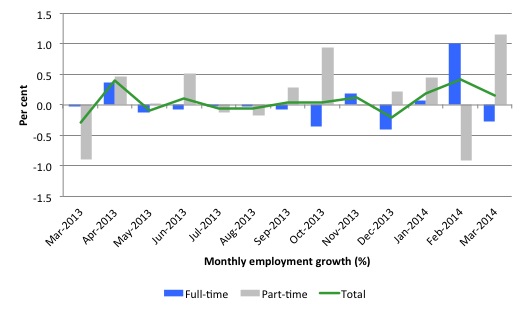
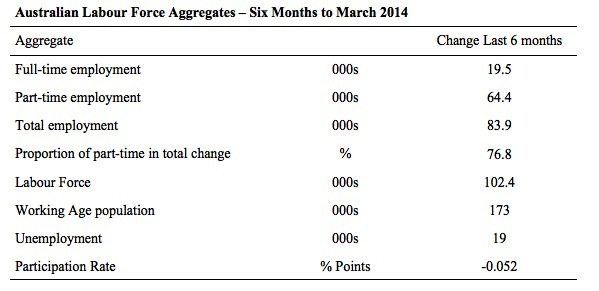
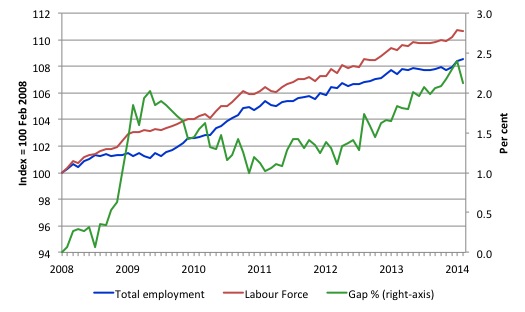
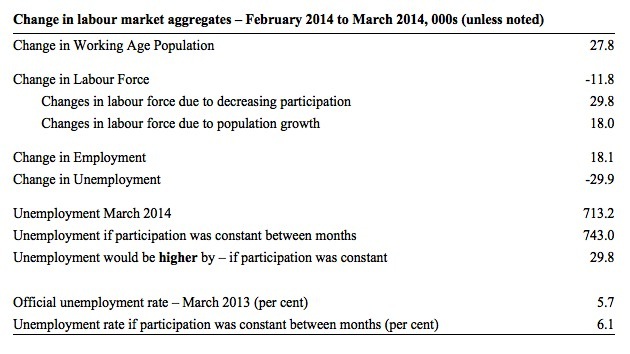
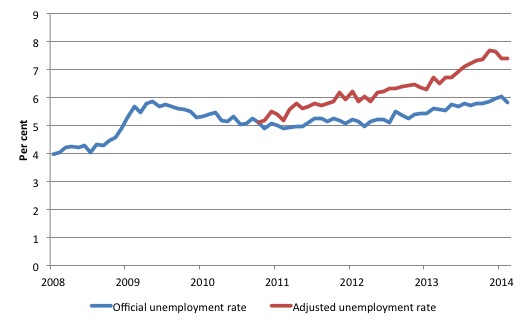
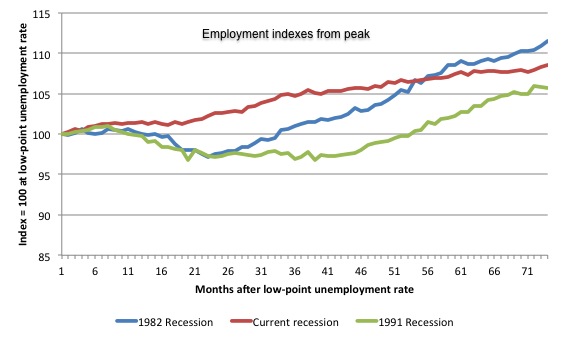

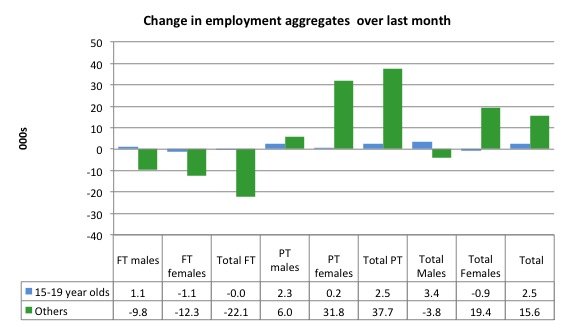
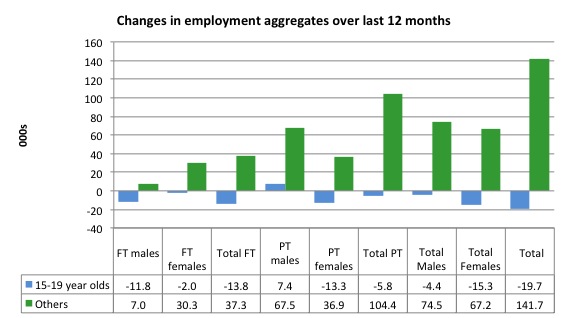
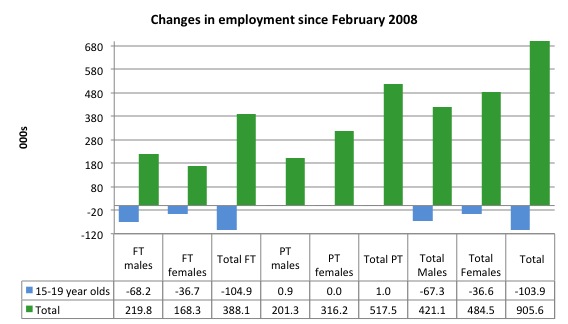
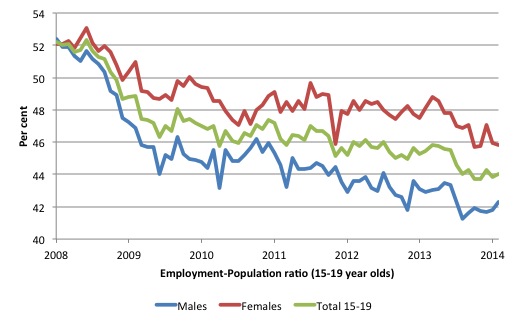
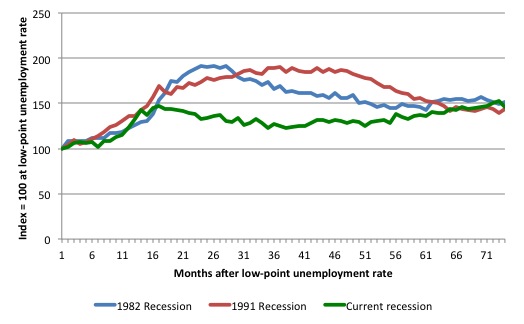
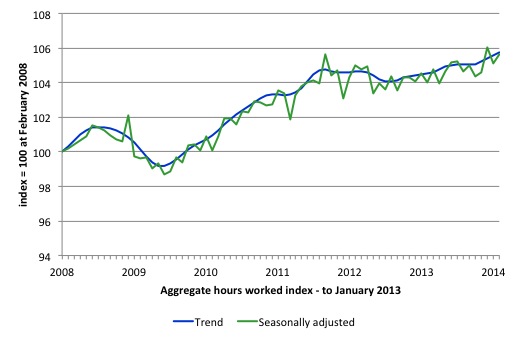
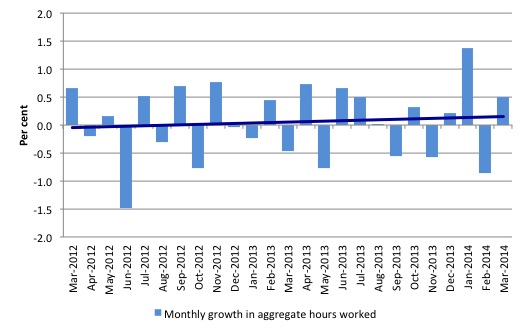
Thanks Bill!
Its all rose tinted glasses in la la land of economics: “Unemployment in shock fall to 5.8%” SMH.com.au
has some imaginary/positive non-quantifiable psycho-babble: “The positive tone in the breadth of the labour market data and ongoing signs of strength in the broad activity indicators may well prompt a discussion over whether we have see the peak for the unemployment rate for this cycle”
ANZ bank is counting job advertisements for its own ‘rose tinted’ opinion. (including presumably counting IT jobs many of which are non-existant and created to cross hire/promote a candidate within a company).
And we’re being told “But while economists said a peak in the jobless rate could be close or have past, it would not rapidly fall due to the continued strong growth in population.”
It seems all to easy for these people in confy jobs wearing suits to sound positive.
Sam, you make a good point on the dubious nature of the ANZ job advertisement series. Anyone who has looked for a job knows that most of the jobs on the Internet simply do not really exist and are designed to compare against internal candidates, multiple recruiters advertising the same job or recruiters just making up job profiles to fill candidate data bases.
I am not sure why anyone believes this series but then I suppose its suits the needs of our corporate masters who keep telling us that everything is fine. Debt to disposable income is now higher then the levels that sent Japan, UK, US into a crisis but this is fine here. Keep spending, keeping going into debt. When it all turns to custard the banks and their mates will buy your assets from under you ant cents in the dollar.
Bill:
I have some basic knowledge of economics from Uni and general interest however I have found your site a breath of fresh air and though I sometimes struggle a little I get the thrust of your arguments and am thoroughly impressed. You have helped remove the fog around quantitative easing and debt and for that I am extremely grateful. I will remain a silent witness.
OK, I want to make several points.
(1) As busy as Bill is, I hope he reads all reader posts. Blogs such as these are the only place that laypersons can vent, advance their own theories (crackpot or not) and gain a smattering of economic knowledge. Although the last can be gained by reading tomes from the library too, provided they are not neoclassical tomes. Since the public economic debate is so simplistic and riddled with easily refutable myths, laypersons who think a bit are starved for genuine commentary and feedback.
(2) Hockey and Abbott are floating all sorts of policy balloons essentially suggesting that we will have an austerity budget this year. Given the poor state of the labour market, which I had inferred from the specious mainstream media reports and now have had confirmed by Bill’s report, I think an Australian recession is in the offing. China shows signs of faltering, Europe is the sick man of Europe (weak joke intended), the Ukraine imbroglio is showing how geopolitics can pop up and play an economic wrecking role and the US economy is scarcely healthy. (A short historical study of US utilisation of manufacturing capacity would be interesting.) Given all these facts, a recession looks on the cards for Australia.
(3) My interests recently have been diverted to Limits to Growth and Peak Everything debates. I still see macroeconomics (and all of political economy) as framed by approaching near real limits. Having said that, I find MMT decriptions and prescriptions form the most credible macroeconomic program (at least without a full workplace democracy and co-operative revolution), whilst noting that the problems we face are much bigger than just macroeconomic policy.
People don’t forget history, the issue is that they don’t read history. Personal history remains embedded and determinative of beliefs and behaviour and is not forgotten, at least until alzheimer’s sets in. History longer than personal history only comes from reading history. The problem for some of us is that we have read enough history to know the broad thrust of capitalist or bourgeois lies about economics. A kind of fatigue sets in. “Do I want to read another history of the endless permutations, combinations and machinations of bourgeois lies, tactics and strategies?” To read it twice, in draft and final, seems a bridge too far for some of us of weaker stamina and hope than Bill, but I will endeavour to read the final.
(4) Canada is an interesting place. Just as Finland is very close to Russia (listen to the Monty Python song), Canada is very close to the USA. Physical proximity to a vast, self-interested superpower always sees the smaller economy and society distorted by the “black hole” gravity field of the superpower. Canada is resisting these forces remarkably well but it is far from immune. AS a person interested in energy economics and indeed thermoeconomics, I find Canada fascinating. I spent 2 months in Canada during the most bitter months of this winter not yet passed. The cold climate energy cost overheads were very clear to see. Canada depends on cheap energy and fortunately has lots of it, for the time being at least. But how much of this energy will the US “black hole” suck away whilst distorting Canadian politics in the process? It’s an interesting dynamic.
Sorry folks, my post above was a bit rambling. I will attempt to be more succinct in future.
Dear Ikonoclast,
The Canadian elites are interested in selling energy. In the fossil fuel sector, a series of pipelines have been proposed, to serve the US, Eastern Canada, and Asian markets. The source for these fuels are the Tar Sands. Meanwhile, the shale gas boom has led to proposals to reverse the flow of natural gas, and sell US natural gas to Canada. Canada may be a net energy exporter, but we also import coal and petroleum to serve the Eastern part of the country.
Canada is currently a nicer place to live than the more established neo-liberal hellholes in the US and Europe. But we are following the same trend. Due to a more favorable balance of trade, Canada’s deficits do not appear to be “as bad”. Unfortunately, the limits to deficit hysteria are being supplemented by Conservative ideology. We are being fed the same guff about austerity, entitlements, and personal responsibility as you Aussies are.